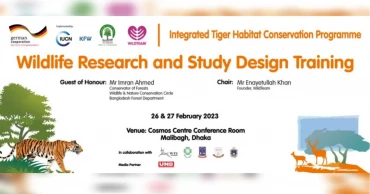Tiger
The Majestic Bengal Tiger: Conservation Success in the Sundarbans
The Sundarbans, the world’s largest mangrove forest, straddling the border of Bangladesh and India, is a vital stronghold for the Bengal tiger (Panthera tigris tigris). In a really engaging interview with the UNB digital team on August 4, 2025, Prof. Dr. Md. Anwarul Islam, the CEO of Wildteam, gave some eye-opening updates about the tigers living in this incredible place and other areas, sharing stories of conservation triumphs and a bit of historical context.
Rising Tiger Numbers in the Bangladesh Sundarbans
Recent surveys indicate a promising upward trend in the tiger population within the Bangladesh portion of the Sundarbans. According to Prof Islam, the Forest Department recorded 106 tigers in 2015 using camera trapping techniques. By 2018, a collaborative effort between the Forest Department and Wildteam counted 114 tigers. The most recent survey in 2024, conducted by the Forest Department, reported 125 adult tigers, reflecting a nearly 10% increase since 2018 and a 17.92% rise since 2015. This growth is attributed to enhanced conservation measures, including anti-poaching patrols and habitat protection initiatives.
The Sundarbans ecosystem is divided between Bangladesh and India, with approximately 60% of the forest located in Bangladesh and 40% in India. Prof Islam noted that while Bangladesh hosts 125 tigers, the Indian Sundarbans is estimated to have around 100 tigers, based on the latest available data from 2022. This brings the total tiger population in the Sundarbans to an estimated 225-250. The mangrove forest, a UNESCO World Heritage Site, is the only mangrove habitat in the world inhabited by tigers, making it a critical conservation area.
Read more: Poacher held with 300 deer traps in Sundarbans
Table 1: Tiger population distribution in the Sundarbans.
Region
Estimated Tiger Count
Percentage of Sundarbans Area
Bangladesh
125 (2024)
60%
India
100 (2022)
40%
Total
225-250
100%
.
Global Tiger Population and India’s Role
According to Prof. Islam, Globally, the tiger population is estimated at approximately 5,500, with India accounting for about 70% of this total, or roughly 3,850 tigers. According to a 2022 census, India’s tiger population stood at 3,682, with key reserves like Jim Corbett (260 tigers), Bandipur (150), and the Sundarbans (100) contributing significantly. This dominance underscores India’s pivotal role in global tiger conservation, supported by initiatives like Project Tiger and the expansion of tiger reserves.
Historical Presence of Tigers in Bangladesh
Prof Islam reflected on the historical distribution of tigers in Bangladesh, noting that they once roamed freely in regions such as Gazipur, Sylhet, Modhupur, and other areas. However, habitat loss, deforestation, and human encroachment have restricted their range to the Sundarbans. He cited an example of a tiger killed in Gazipur approximately 100 years ago, illustrating the significant contraction of tiger habitats over time. Today, the Sundarbans remains the last refuge for tigers in Bangladesh, emphasizing the need to protect this critical ecosystem.
Read more: UNESCO World Heritage Sites in Bangladesh
Clarifying the Royal Bengal Tiger
A common misconception is that the "Royal Bengal tiger" is a distinct subspecies. Prof Islam clarified that the term refers to the habitat rather than a unique taxonomic classification. The Bengal tiger (Panthera tigris tigris) is found across Bangladesh, India, Myanmar, Nepal, and Bhutan, thriving in diverse environments from mangrove swamps to deciduous forests. The Sundarbans’ tigers are morphologically distinct due to their adaptation to the mangrove habitat, but they are part of the broader Bengal tiger population.
Tiger Subspecies and Habitat Loss
Historically, there were nine recognized tiger subspecies, but only six remain today due to extinction events over the past century. These include:
Bengal tiger (Panthera tigris tigris): Found in India, Bangladesh, Nepal, Bhutan, and Myanmar.Indochinese tiger (Panthera tigris corbetti): Inhabits Cambodia, Laos, Myanmar, Thailand, and Vietnam.Malayan tiger (Panthera tigris jacksoni): Found in peninsular Malaysia.Siberian tiger (Panthera tigris altaica): Resides in the Russian Far East and parts of China.Sumatran tiger (Panthera tigris sondaica): Found only on the Indonesian island of Sumatra.South China tiger (Panthera tigris amoyensis): Functionally extinct in the wild, with small populations in captivity.
Prof. Islam’s words stayed with me. The Sundarbans’ 125 tigers in Bangladesh are a sign of hope, thanks to years of hard work. But the fight isn’t over. We need to keep protecting this forest. The Bengal tiger, with its quiet strength, depends on the Sundarbans and on us. This interview reminded me why we can’t look away from this fight to save a piece of our wild heritage.
Read more: Govt to ban new industrial units within 10km of Sundarbans ECA
4 months ago
No narcotic substances found in energy drinks: Industries Minister
Industries Minister Nurul Majid Mahmud Humayun on Thursday told Parliament that soft drinks like Tiger, Speed and Guru, which are being marketed, took licences as carbonated beverage from the Bangladesh Standards and Testing Institution (BSTI) following proper procedures.
“No presence of narcotic substances were found in the samples of beverage products (Speed, Royal Tiger, Black Horse, Bulldozer, Power, Guru, Gear, Strong and Red Bull) by the Department of Narcotics Control and the Directorate General of Drug Administration,” he said.
Bangladesh should discuss issues related to trade benefits at WTO ministerial conf: speakers at a seminar
The minister said this replying to a question from Awami League lawmaker Nurunnabi Chowdhury (Bhola-3) during the question-answer session in the House.
In the question, the lawmaker wanted to know if it is true that the energy drinks in the name of energy are injecting dangerous diseases into the human body, and many brands contain narcotic ingredients, energy drinks of 27 brands are being sold under fake licences of the BSTI, aphrodisiac Viagra ingredients are being mixed, energy drinks have become soft drinks through tax evasion. He also wanted to know whether the BSTI will take strict action against these, if the allegations are true.
Bangladesh is doing well in IMF terms: Finance Minister
The industries minister said the government has so far brought 273 products under the BSTI. Energy drinks are not considered as compulsory products in the country.
However, the locally produced drinks like Tiger, Speed, Guru and others, which are being marketed in the country, collected the BSTI licences as carbonated beverages following the proper procedures, he said.
Electricity demand may rise to about 17,500 MW in coming summer: Nasrul
In the last one year, as many as 237 samples of the drink items were collected and tested in the labs. “But all the samples succeeded as per Bangladesh standards,” said Nurul Majid.
He, however, said monitoring continues against the mixture of narcotics with drinks and the marketing of drinks in the name of energy drinks.
1 year ago
Fence to be erected in parts of Sundarbans to tackle human-tiger conflicts
The Forest Department of Bangladesh will install nylon fence at critical locations in the Sundarbans and provide awareness training, aiming to resolve tiger-human conflicts, and increase the tiger population in the world’s largest mangrove forest.
These initiatives are part of a special project of the Forest Department named 'Sundarbans Tiger Conservation Project'.The implementation of the project, with a budget of Tk 35.90 crores, began in April 2022 scheduled for completion in March 202, according to the project director’s office.
Read: Govt measures boost hilsa production in Khulna
Under this project, various activities were planned including a survey of the tigers and prey animals in the Sundarbans, the construction of high dunes and watchtowers, research on canine distemper virus in tigers, and awareness training for VTRT and CPG members, it said.
To prevent tigers from entering nearby localities from the Sundarbans, nylon fence will be erected in 4 to 5 km critical locations initially. If this proves successful, 60 km area will be brought under fencing.
The Forest Department expressed hopes that the successful implementation of this project will resolve tiger-human conflicts, reduce human-induced tiger killings, and increase the tiger population.
Read: Khulna fuel traders start indefinite strike with 3-point demand
The primary focus of the project is the survey of tigers and prey animals. So far, camera trapping surveys have been completed for tigers, prey animals, and canals in the Khulna and Satkhira ranges under Sundarbans West Forest Division.
The survey in the Sharankhola and Chandpai ranges under East Forest Division is set to commence in November, with the report expected to be published in July 2024.
Abu Nasser Mohsin Hossain, Divisional Forest Officer of Sundarbans West Forest Division and Project Director of the Sundarban Tiger Conservation Project, said camera trapping work for the tiger survey in Satkhira and Khulna ranges has been successfully completed.
All officers and employees of the Sundarbans East and West Forest Divisions will undergo training to enhance their tiger conservation skills.
Read: Rail link with Khulna restored after 7 hours
“Training sessions for CPG and VTRT members will start soon. Additionally, several activities are planned for tiger conservation and increasing their numbers,” he said.
“All project activities will be documented on video, and these recordings will be used to create documentary films. These films will later prove valuable to officials and volunteers dedicated to Sundarbans and tiger conservation,” he added.
According to the project plan, 12 high dunes will be constructed inside the Sundarbans to offer shelter to tigers during floods, storms, and high tides. A tower will also be installed in the Dhansagar area of the Sarankhola range tiger sanctuary to monitor fires. From this tower, forest guards and volunteers will be able to swiftly manage fires in the Sundarbans in that region.
As part of the project, research will be conducted on the canine distemper virus. Tiger feces will be collected from the Sundarbans, and domestic researchers will study the virus infection in the tigers' teeth through these fecal samples.
Read: Onion prices soar in Khulna market after India slaps duty on export
On the other hand, 340 members of the Village Tiger Response Team (VTRT) and 184 members of the Community Patrol Group (CPG) will receive training to resolve human-tiger conflicts in the Sundarbans.
Additionally, two tigers that often enter the locality will be fitted with satellite trackers. Forest officers will provide apps to CPG and VTRT members for tracking tigers' movements, allowing them to monitor tiger activity on their mobile phones. Consequently, if a tiger approaches the locality, they will be able to quickly guide it back to the Sundarbans.
Furthermore, for the project's implementation, various equipment such as drone cameras, satellite trackers, nylon fences, GPS devices, tranquilizing agents for tiger sedation, cameras, VTRT equipment, and various auxiliary materials, including clothing and training materials for CPG members, will be procured.
Read more: Save Sundarbans, save Bangladesh: Environmentalists call for protecting largest mangrove forest
2 years ago
Transboundary Collaboration with India needed for Bengal Tiger conservation: Environment Minister
Environment, Forest and Climate Change Minister Md. Shahab Uddin stressed the need for strengthening the transboundary collaboration with India for the conservation of tigers and leopards in Bangladesh as the two countries have shared tiger and leopard habitat.
“Considering the conservation importance of seven big cat species on earth and two critically endangered big cat species in Bangladesh, we in principal support the creation of the International Big Cats Alliance (IBCA) with a membership of the range of countries harboring these species,” he said.
The minister said this at an event organized on the occasion of the International Conference on Tiger Conservation as part of 50 years of Project Tiger held on Sunday at Mysuru University in Mysuru, Karnataka, India after the inauguration of the event by Prime Minister of India Narendra Modi.
Sahab Uddin said Bangladesh government is working with the determination to double the number of wild tigers by achieving zero poaching target with the active participation of local community.
It’s a matter of hope that wild tiger numbers are starting to tick upward he said adding that government has taken several remarkable initiatives for conserving the national animal and other wild species.
Shahab Uddin said Bangladesh government is implementing National Tiger Recovery Program (2022 to 2034) and second-generation Bangladesh Tiger Action Plan (2018-2027) which include tiger survey; genetic study; SMART patrolling and monitoring by drone inside the Sundarbans; capacity building programs for frontline staffs of the Forest Department as well as local community to ensure protection & conservation of the Sundarbans and Bengal tiger.
The Minister said, a protocol was signed between Bangladesh and India for strengthening collaboration for the Conservation of Royal Bengal Tiger in the Sundarbans in 2011.
The Minister said to mitigate tiger human conflicts, our government has engaged the local community in tiger conservation activities by forming Village Tiger Response Team, Co-management Committee and Community Petrol Group.
Wildlife Victim Compensation Rules, 2021 has the provision to give compensation up toTk 3 lakh for person killed by tiger, he said.
Wildlife Crime Control Unit has been established under Forest Department to combat illegal wildlife trade and to strengthen the capacity of wildlife education, research and training, Sheikh Kamal Wildlife Center has been established which is working as a center of excellence, said the minister.
Prime Minister of India Narendra Modi launched the International Big Cats Alliance (IBCA) which will focus on protection and conservation of seven major big cats of the world such as tiger, lion, leopard, snow leopard, puma, jaguar, and cheetah in collaboration with the countries concerned.
The Environment and Forest Ministers of the countries harboring these species were present on the occasion.
2 years ago
As tiger count grows, India’s Indigenous demand land rights
Just hours away from several of India's major tiger reserves in the southern city of Mysuru, Prime Minister Narendra Modi is set to announce Sunday how much the country's tiger population has recovered since its flagship conservation program began 50 years ago.
Protesters, meanwhile, will tell their own stories of how they have been displaced by such wildlife conservation projects over the last half-century.
Project Tiger began in 1973 after a census of the big cats found India’s tigers were fast going extinct through habitat loss, unregulated sport hunting, increased poaching and retaliatory killing by people. Laws attempted to address those issues, but the conservation model centered around creating protected reserves where ecosystems can function undisturbed by people.
Several Indigenous groups say the conservation strategies, deeply influenced by American environmentalism, meant uprooting numerous communities that had lived in the forests for millennia.
Members of several Indigenous or Adivasi groups — as Indigenous people are known in the country — set up the Nagarahole Adivasi Forest Rights Establishment Committee to protest evictions from their ancestral lands and seek a voice in how the forests are managed.
“Nagarahole was one of the first forests to be brought under Project Tiger and our parents and grandparents were probably among the first to be forced out of the forests in the name of conservation,” said J. A. Shivu, 27, who belongs to the Jenu Kuruba tribe. “We have lost all rights to visit our lands, temples or even collect honey from the forests. How can we continue living like this?”
The fewer than 40,000 Jenu Kuruba people are one of the 75 tribal groups that the Indian government classifies as particularly vulnerable. Jenu, which means honey in the southern Indian Kannada language, is the tribe’s primary source of livelihood as they collect it from beehives in the forests to sell. Adivasi communities like the Jenu Kurubas are among the poorest in India.
Experts say conservation policies that attempted to protect a pristine wilderness were influenced by prejudices against local communities.
The Indian government's tribal affairs ministry has repeatedly said it is working on Adivasi rights. Only about 1% of the more than 100 million Adivasis in India have been granted any rights over forest lands despite a government forest rights law, passed in 2006, that aimed to “undo the historical injustice" for forest communities.
Their Indigenous lands are also being squeezed by climate change, with more frequent forest fires spurred by extreme heat and unpredictable rainfall.
India's tiger numbers, meanwhile, are ticking upwards: the country's 2,967 tigers account for more than 75% of the world’s wild tiger population. India has more tigers than its protected spaces can hold, with the cats also now living at the edge of cities and in sugarcane fields.
Tigers have disappeared in Bali and Java and China’s tigers are likely extinct in the wild. The Sunda Island tiger, the other sub-species, is only found in Sumatra. India's project to safeguard them has been praised as a success by many.
“Project Tiger hardly has a parallel in the world since a scheme of this scale and magnitude has not been so successful elsewhere,” said SP Yadav, a senior Indian government official in charge of Project Tiger.
But critics say the social costs of fortress conservation — where forest departments protect wildlife and prevent local communities from entering forest regions — is high. Sharachchandra Lele, of the Bengaluru-based Ashoka Trust for Research in Ecology and the Environment, said the conservation model is outdated.
"There are already successful examples of forests managed by local communities in collaboration with government officials and tiger numbers have actually increased even while people have benefited in these regions,” he said.
Vidya Athreya, the director of Wildlife Conservation Society in India who has been studying the interactions between large cats and humans for the last two decades, agreed.
“Traditionally we always put wildlife over people,” Athreya said, adding that engaging with communities is the way forward for protecting wildlife in India.
Shivu, from the Jenu Kuruba tribe, wants to go back to a life where Indigenous communities and tigers lived together.
“We consider them gods and us the custodians of these forests,” he said.
2 years ago
WildTeam’s Tiger Conservation workshop concludes
Vowing to work together for the greater good of wildlife conservation, WildTeam’s two-day Integrated Tiger Habitat Conservation workshop came to its closure on Monday at Cosmos Centre in the capital.
The two-day workshop, an exclusive collaboration between WildTeam and the Bangladesh Forest Department, Wildlife Trust of India, Jahangirnagar University, Dhaka University, Jagannath University, and Noakhali University of Science and Technology, turned into a rendezvous with the enthusiastic participation of a large number of aspiring wildlife researchers, educators and students.
Continuing the successful and effective series of sessions, the second day of the exclusive workshop began with the ‘Basics of Radio-telemetry for monitoring wildlife’ session which was conducted by Dr Rajiv Kalsi from 10 am to 10:45 pm, followed by his two other sessions - ‘Estimating densities using distance sampling’ from 11:00-11:30 am and ‘Use of Mark-Recapture for generating estimates’ from 11:30 am to 12:00 pm.
A group activity session was then conducted for the participants, from 12:00 pm to 1 pm by Dr Kamalka Bhattacharyyay alongside Dr Rajiv Kalsi. After that, two virtual sessions were held following the lunch break: ‘Estimating and conserving the patterns of diversity using field survey data’ by Dr Md Anwar Hossain and ‘Human-Tiger Interactions’ by Dr Medha Nayak (from India). The later session comprised another activity: ‘List causes and drivers of Human Tiger Conflict in Sundarbans’.
Read more: WildTeam’s tiger conservation workshop begins at Cosmos Centre
The final session of the workshop was conducted by Prof M Abdul Aziz from Jahangirnagar University from 3 pm to 4:30 pm, titled ‘Camera trapping in the Sundarbans and demonstration’.
After a 15-minute post-training evaluation test for participants followed by another feedback session of the same duration, the workshop officially came to its closure with its closing ceremony and certificate distribution among the participants and the workshop conductors-associates.
Chaired by WildTeam Founder and Cosmos Foundation Chairman Enayetullah Khan, the concluding session was moderated by Dr Md Anwarul Islam, CEO and spokesperson for WildTeam and also joined by WildTeam Chairman and renowned Ornithologist Enam Ul Haque, Deputy Managing Director of Cosmos Group Masud Khan, JU Professor M Abdul Aziz, innovative conservationist Noam Bedein and two of the workshop facilitators from Wildlife Trust India, Dr Kamalka Bhattacharyyay and Dr Rajiv Kalsi.
“When one stops to learn, the person stops to live - and it is as simple as that. We all have to die, today or tomorrow; but I think many people die much before their physical death when they lost the inspiration to learn. Personally, I am very happy to see all of you aspirant wildlife researchers here together and especially the participation of our female participants, as I believe the contribution of our female population to society is enormous,” Enayetullah Khan lauded the participants at the closing ceremony.
“I have seen WildTeam’s journey and struggles from its beginning,” Masud Khan said at the ceremony. “My father Enayetullah Khan, alongside Enam Ul Haque, Professor Anwarul Islam and the entire WildTeam has been working for effective conservation through struggles, efforts and sacrifices. I am very happy to explore this successful workshop, and I wish the best to all the participators-facilitators and the whole team.”
Lauding WildTeam for hosting this exclusive research workshop, Dr Rajiv Kalsi said, “Wildlife conservation is an urgency of our time. No government can do it alone, so I really appreciate Cosmos and WildTeam for this workshop.”
2 years ago
WildTeam’s tiger conservation workshop begins at Cosmos Centre
Focusing on empowering the aspiring wildlife researchers, leading environmental conservation organization WildTeam’s two-day workshop titled ‘Integrated Tiger Habitat Conservation Programme’ was inaugurated on Sunday at the Padma Conference Room, Cosmos Centre in the capital’s Malibagh.
The workshop aims to provide participants with the knowledge and skills necessary to plan, design and conduct successful wildlife research projects, covering a range of topics including the principles of research design, field data collection techniques, data analysis, and report writing. The workshop is also designed to provide the participants with the latest tools and technologies used in wildlife research, including GPS tracking, remote sensing, and camera traps.
On Sunday morning, the workshop was formally launched with an inaugural speech session, followed by the introduction to the course module. Imran Ahmed, Conservator of Forests, Wildlife and Nature Conservation Circle, Bangladesh Forest Department joined the introductory session as the guest of honor.
Read more: Integrated Tiger Habitat Conservation: WildTeam hosting workshop at Cosmos Centre on Feb 26-27
Chaired by Enayetullah Khan, Founder of WildTeam and Chairman of Cosmos Foundation, the introductory session was moderated by Dr Md Anwarul Islam, CEO and spokesperson for WildTeam and also joined by.Caren Blume, Head of Development Section, the Embassy of Germany in Dhaka, and Dr Elke Hellstern, Member of the Programme Council, Integrated Tiger Habitat Conservation Programme at the KFW Development Bank, Germany.
2 years ago
Integrated Tiger Habitat Conservation: WildTeam hosting workshop at Cosmos Centre on Feb 26-27
Dhaka, Feb 25 (UNB) – WildTeam, a leading environmental conservation organization, is set to host a two-day workshop titled ‘Integrated Tiger Habitat Conservation Programme’ on February 26 and 27 at the Padma Conference Room, Cosmos Center in Malibagh, Dhaka.
The workshop aims to provide participants with the knowledge and skills necessary to plan, design and conduct successful wildlife research projects.
The WildTeam workshop is an exclusive collaboration with the Bangladesh Forest Department, Wildlife Trust of India, Jahangirnagar University, Dhaka University, Jagannath University, and Noakhali University of Science and Technology. Participants with an interest in wildlife research, including research students, researchers, and professionals will have the opportunity to learn from experienced researchers and practitioners in the field of wildlife biology and conservation.
This will be the first time that researchers from India and Bangladesh will gather and share their thoughts, knowledge, and practice initiatives on what should be done for the betterment of wildlife conservation.
Also Read: 300 sheltered at WildTeam’s Conservation Biology Centre during Sitrang
Imran Ahmed, Conservator of Forests, Wildlife and Nature Conservation Circle, Bangladesh Forest Department, will join the workshop as the guest of honour, while the workshop will be chaired by Enayetullah Khan, Founder of WildTeam and Chairman of Cosmos Foundation.
The workshop will cover a range of topics, including the principles of research design, field data collection techniques, data analysis, and report writing. In addition, participants will learn about the latest tools and technologies used in wildlife research, including GPS tracking, remote sensing, and camera traps. A total of 50 participants are set to join the two-day workshop, from 9:30 am to 5:00 pm on day one (February 26) and 10:00 am to 4:45 pm on day two (February 27).
“We are thrilled to host this workshop and provide participants with the skills and knowledge they need to conduct successful wildlife research,” said Professor Dr Md Anwarul Islam, CEO and spokesperson for WildTeam. “We believe that this workshop will be an excellent opportunity for participants to learn from experienced researchers and practitioners and to network with others in the field.”
The event includes all workshop materials, refreshments, and lunch on both days. Participants will also receive certificates at the closing ceremony of this exclusive workshop.
About WildTeam:
WildTeam is a leading environmental organization committed to protecting wildlife and their habitats. The organization's mission is to work with communities, governments, and other stakeholders to promote sustainable wildlife conservation and management practices.
2 years ago
An unseen presence: Fear of tiger attack grips 6 villages along Sundarbans
The residents of six villages near the Sundarbans are literally living in fear for their lives as a hundred footprints of two tigers were spotted in Sonatala village of Bagerhat’s Sharonkhola.
Two tigers left the Sundarbans and crossed the Bhola river and entered the village early hours of Thursday (January 12) and roamed over an area of about one kilometer of Sonatala village, said Divisional Forest Officer (DFO) of Sundarbans East Division Muhammad Belayet Hossain.
Later, the forest department, Village Tiger Response Team (VTRT), Community Patrolling Group (CPG) and villagers searched various areas throughout the day in search of the tigers. However, no tiger was found in that village till Thursday evening, he added.
Read more: Tiger census: Installation of cameras begins in Sundarbans
The two tigers went back to the forest after roaming different places in that village, claimed the Forest Department after tracing all the footprints the tigers left on the ground. However, villagers were advised to stay on alert, and have just spent an anxious weekend remaining vigilant.
With this, tigers have left the Sundarbans and entered the locality more than 50 times in the last 15 years. During this time, both man and tiger have lost their lives due to counter-attacks.
Villagers demanded effective measures to prevent tigers from entering the locality.
Harun Bhadda of Sonatala village said that he woke up early in the morning and saw hundreds of the unmistakable imprints of the tiger's paw around his house. Ever since seeing them, his entire family has been gripped by fear of tigers.
Read More: Panic after tiger strays into Satkhira village
In Sonatala village, the Bhola River has almost filled up with silt and has only two to two-and-a-half feet of water. In the Tajur Gate area under the Bhola camp of the Sharonkhola range of the Sundarbans East Division, countless tiger footprints were spotted on the river bed.
2 years ago
Tiger census: Installation of cameras begins in Sundarbans
The Forest Department has started setting up a total of 1,330 cameras at 665 spots in the Sundarbans to count tigers, deer and pigs.
Abu Naser, forest official of Sundarbans West zone and director of Sundarbans Tiger Conservation Project’ project, said the camera installation work started at Kalabogi Ecotourism Center around 9 am on Sunday (January 01, 2023).
The Forest Department – under the ‘Sundarbans Tiger Conservation Project’ involving Tk 3.27 crore – took preparations for installing cameras on both sides of the canals under Kalabogi Forest Station of Khulna Range from December 15 last year.
Abu Naser said apart from counting tigers, this year, the Forest Department will count deer and pigs as well under the project.
Read more: Killing tigers in the Sundarbans: Offenders get off scot-free for lack for evidence
They have divided the project into two categories – camera trapping and canal survey. Primarily, the survey along both sides of the canals in Sundarbans has started and through the process, the movement and pugmarks of tigers will be pointed out.”
Through the camera trapping process, the authorities concerned will take snaps for two years and later they will analyse the photos captured for the next two months, and after that they will figure out the numbers, he said.
A technical committee has already been formed and the committee decided to install cameras at 665 spots, he added. Of these, 200 will be set up in Satkhira range, 140 in Khulna range, 180 in Sharankhola and 145 in Chandpai range of the Sundarbans, said Abu Naser.
Two cameras will be installed in each grid and a total of 1,330 cameras will be set up.
Read more: Sundarban tigers: Inbreeding leads to generation of weak, diseased cubs
Asked about the number of tigers, the project director said, “The exact figure of tigers will be known after the census. Earlier, it was difficult for tourists to see any tiger during their Sundarbans visit but now, they can take photos of 3-4 tigers which indicates that the number might have increased.”
The tiger census will be conducted in and outside the wildlife sanctuary and the authorities concerned will conduct the survey in the less, more and most saline areas of the Sundarbans, he said.
Tigers mostly hunt deer, but they also eat pigs, monkeys and crabs and another survey will be conducted to figure out their eating habits in 2024, he added.
Three hundred and forty members under 49 village tiger response teams and 185 members of community patrol groups under the four ranges will be given training to conduct the survey.
Read more: Sundarbans to have 4 more eco-tourism centres
Resident launches and support boats have been hired for four months under the projects while 200 special category cameras, battery, and SD cards will be purchased.
Mihir Kumar Doe, forest conservator of Khulna Circle, said the project includes monitoring the movement by setting up satellite collars on two tigers, identifying diseases and infections among tigers, collecting data and publishing a report after research.
Besides, fire extinguishing equipment, pipes and drones will also be purchased using the funds to save tigers from forest fires during dry season.
Alongside, an initiative will be taken to erect fences in 60 km areas of the Sundarbans, using nylon, to prevent the entry of tigers into villages, he said.
Read More: Counting tigers in Sundarbans: Forest Dept to set up 1,330 cameras under Khulna Range from Jan 1
Besides, 12 towers will be set up in the Sundarbans to protect tigers from cyclonic storms, said Mihir Kumar. Under the project, twelve consultant experts have been hired in the short term for special training, survey completion, data collection, preparation of report and analysis, he said.
On March 23 last year, the Ministry of Environment, Forest and Climate Change gave its nod to the project, involving Tk 35.93 crore. Of the project, only Tk 3.27 crore will be spent for tiger census and the tenure of the project is fixed from April 2022 to June 2025.
There are 3,840 tigers in 13 countries of the world. In 2015, the number of tigers in the Sundarbans was 106 and in 2018, that number went up to 114. Of these, 63 are mature, 18 between the age of 12-14 months, and 33 are cubs.
Read More: Tiger range countries should work together to save the tigers: Minister
3 years ago



















